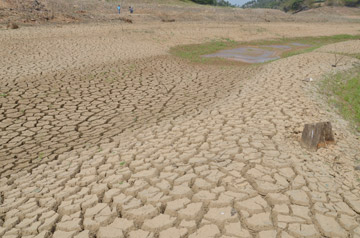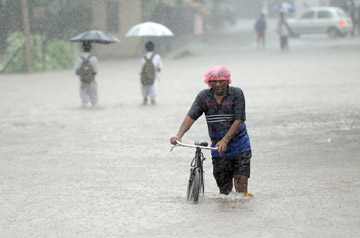|
Getting parched:
Sri Lanka's climate challenge
by Dhaneshi Yatawara
Weather patterns in the country have drastically changed and
continues to be so, with droughts getting prolonged and rainfall patters
becoming erratic.
 |
|
Extreme weather events will
increase droughts in Sri Lanka.
Pic: ANCL library |
According to Director, Research and Development Division of the
Meteorology Department, S. Premalal, and the weather changes in the
island are a result of significant climatic change at a global scale.
"There is a clear change in the rain patterns which is a result of
global climate change. Sri Lanka, like other countries, is now facing
the consequences of a global phenomenon," he explained.
What is alarming though is the greater risk of drought: Sri Lanka's
current real challenge, according to the weather expert.
Future droughts will have a greater impact as demand for water
resources increases as a result of population growth and economic
development that would result in depletion of natural water resources
and excessive extraction, to support developmental activities.
Absence of data
What is disturbing in all this is that up to now, a comprehensive
analysis as far as climate variability at a national scale being not
available.
Experts point out that it could be due to the fact that climate
change impact analysis is a complicated subject, requiring data
collected over a lengthy period.
According to the Sri Lanka Hazard Profile, 11 agro-ecological areas
of the Dry Zone have a greater degree of facing drought, while all the
20 agro-ecological areas of the Intermediate Zone face moderate or high
degree drought risk.
While droughts pose a great threat, with the change in the weather
patterns, the danger of having to face hydrological disasters -
disasters that take place due to changes in the quality of the earth's
water or in its distribution or movement of water below the surface or
in the atmosphere- too has increased.
 |
|
Prof. Rohan Samarajiva |
Floods and landslides are a result of the changes in the weather
pattern, explained Professor Rohan Samarajiva, an expert in disaster
management and the founding chair of LIRNEasia, the South Asian think
tank which looks at disaster management through a regional lens.
"Definitely we are in a much advanced stage than we were in 2004with
regard to disaster management and preparedness. But we need to find the
right balance,†said Professor Samarajiva, referring to the
preparedness of the country to face the drastic changes in weather
patterns.
Prof. Samarajiva added that scientists should be involved in making
judgments based on scientific evidence. “But scientists cannot take
the final responsibility "line ministries and authorities at national
and local levels must get involved," he pointed out.
In the Ratnapura District, over 3.3 million people have been affected
by natural disasters through the years, which is the largest number of
people affected in the country, according to the Sri Lankaâ€(tm)s 2012
Hazard Profile. Numbers have clearly increased then.
The tsunami, the biggest natural disaster to have struck Sri Lanka in
the recent years, caused the highest number of deaths and immediate
displacement.
Yet, Sri Lanka has come a long way in managing natural disasters,
though still facing many challenges - now of a different kind, with the
intensity of changing weather patterns. Natural hazards are the result
of extreme weather patterns. Changed rain patterns and intense spells of
drought, continue to affect the Sri Lankan community.
Though it appears as if rainfall has increased, meteorologists point
out that there is no significant change in the annual average rainfall,
S. Premalal said. According to meteorological studies and observations,
it is the variability of rain that has changed. One result of such
variability is the drought spells between seasonal rainfall. In certain
areas, the weather is anyway dry, so we cannot categorize this as
drought," Premalal said.
Studies are continuing in the Meteorology Department with regard to
the change in the weather patterns. "Many scientists and universities
are conducting different studies and there is institutional research
going on," he added.
However, science related to landslide detections have significantly
advanced within the past few years.
The National Building Research Organization (NBRO) is involved with
early detection of landslides and people are being currently educated on
how to detect landslides and when to evacuate.
"How they will continue their lives after being evacuated is another
question altogether," Prof. Samarajiva remarked.
"Insurance is the only option for these people because in the event
of a disaster there should be a means of redress," he said.
In the case of floods, Prof. Samarajiva said that Sri Lanka needed to
go beyond the traditional methods and adopt high-tech automated early
warning systems linked to a main observation centre.
 |
|
Flooded roads.
Pic: ANCL library |
"The main problem with floods is the damage to property. Techniques
need to be adopted for property affected by disaster. Insurance and
adopting different building standards in flood prone areas and the
sustainable solution is to find a safe way of life," he added.
Cyclones
"Cyclones are predictable and if we take the biggest cyclone to hit
Sri Lanka in the 1970s, many lives were saved, though we had less time
for evacuation and had to grapple with available technology," he said.
"The question is to get this information disseminated to the people,
how to plan the evacuation and do we have safe evacuation locations. In
this aspect Bangladesh has adopted a comparatively successful system
where we can learn," he noted.
Cell broadcasting - Sri Lanka has fortunately done much in
implementing this technology and would be a life saver in a disaster.
This option has been activated by many local telecommunication
companies. Software is activated in Sri Lanka and is ready to be used at
times of disaster. But frequent drills can be counterproductive because
people may not have a rapid response when the real disaster happens, he
said.
Making the state prepared for possible multiple disasters, the
Disaster Management Council(DMC) met recently after a lapse of two
years, noted Anoja Seneviratne, Director of the Mitigation, Research and
Development Division of the National Disaster Management Centre. "A lot
of preparation went in to it and the next phase will lay a solid
foundation for Sri Lanka to face challenges related to disasters,
irrespective of the type and scale," she added. |

